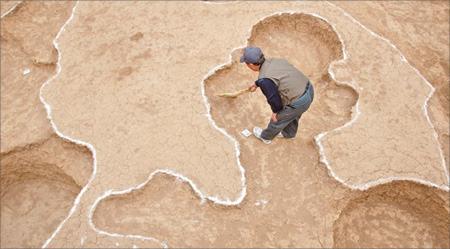Dig site gives glimpse into ancient daily life
 |
|
An archaeologist cleans the surface of an excavation site at Hujiaying village in Yanqing county on Friday. |
An accidental find on a routine dig on the outskirts of the capital Beijing led to rare discoveries, Qin Zhongwei discovers.
More Chinese today are obsessed with watching history-themed TV soap operas or reading best-selling history books to learn about China's rich history. But there is no better way to see history first-hand than to visit an archaeological site.
During a recent visit to a newly discovered archaeological site in Yanqing county, in Beijing's northwestern suburbs, China Daily went back more than 2,000 years and saw how people lived their daily lives in ancient China.
Uncovered at Hujiaying village, in Zhangshanying town, Yanqing, the Hujiaying archaeological site contains the ruins of an ancient village, which might be where a tribe lived from the mid- to late-Eastern Zhou period (770 to 256 BC).
The site contains many cultural remains that probably date from that period.
Like many such archaeological discoveries, this one started with an accidental find while a team was conducting a routine archaeological investigation before work was due to began on a road-building project in March. A team member unearthed something special with his Luoyang shovel, a standard tool used in archeological excavations, and the team members soon enlarged the area of the investigation. Before long they had lifted the veil of time on a sizable archaeological site.
On the site are the remains of the foundations of 24 houses, 21 ash pits, where the ancient people dumped their garbage, and 11 kitchen stoves. There are also four ditches still being dug on the site, which has been divided into two excavation grids. Area A has 20 10-square-meter sections and area B on the northern side has six 10-sq-m grids.
According to Cheng Jinlong, director of Yanqing County's Cultural Relic Management Institute, this site is the first one of a village from the Eastern Zhou period to be discovered in suburban Beijing.
"As most of our other discoveries were burial sites, this is a very rare discovery as it records people's living conditions," Cheng said. "Fortunately, the remains are comparatively well preserved."
Most of the house remains uncovered are semi-subterranean, only 1.5 meters deep.
Go to Forum >>0 Comments
 Add your comments...
Add your comments...
- User Name Required
- Your Comment
- Racist, abusive and off-topic comments may be removed by the moderator.
 0
0 






